刘润清《新编语言学教程》Syntax教学课件
- 格式:ppt
- 大小:508.50 KB
- 文档页数:65

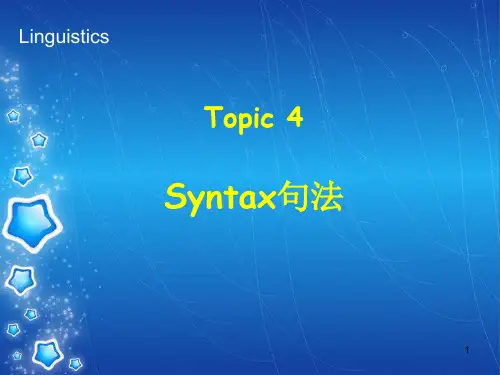

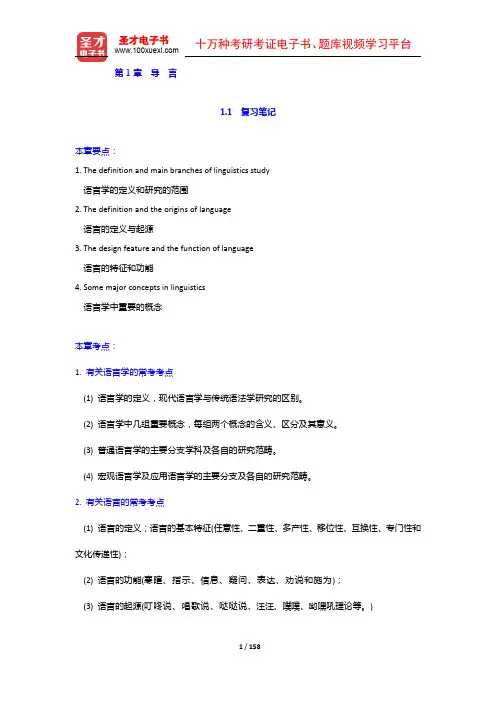
第1章导言1.1复习笔记本章要点:1.The definition and main branches of linguistics study语言学的定义和研究的范围2.The definition and the origins of language语言的定义与起源3.The design feature and the function of language语言的特征和功能4.Some major concepts in linguistics语言学中重要的概念本章考点:1.有关语言学的常考考点(1)语言学的定义,现代语言学与传统语法学研究的区别。
(2)语言学中几组重要概念,每组两个概念的含义、区分及其意义。
(3)普通语言学的主要分支学科及各自的研究范畴。
(4)宏观语言学及应用语言学的主要分支及各自的研究范畴。
2.有关语言的常考考点(1)语言的定义;语言的基本特征(任意性、二重性、多产性、移位性、互换性、专门性和文化传递性);(2)语言的功能(寒暄、指示、信息、疑问、表达、劝说和施为);(3)语言的起源(叮咚说、唱歌说、哒哒说、汪汪、噗噗、哟嘿吼理论等。
)本章内容索引:I.Definition of linguisticsII.Linguistics vs.traditional grammarIII.Scope of linguistics1.Microlinguistics2.MacrolinguisticsIV.Definition of languageV.Origins of language1.Ding-Dong Theory2.Sing-Song Theory3.Pooh-Pooh Theory4.Yo-He-Ho Theory5.Ta-Ta Theory6.Bow-Wow TheoryVI.Design features of language1.Arbitrariness2.Duality3.Productivity4.Interchangeability5.Displacement6.Specialization7.Cultural transmissionVII.Functions of language1.Phatic function/communion2.Directive functionrmative function4.Interrogative function5.Expressive function6.Evocative function7.Performative functionVIII.Some major concepts in linguistics1.Descriptive and prescriptive grammar2.Synchronic and diachronic linguisticsngue and parolepetence and performance5.Syntagmatic and paradigmatic relations6.Functionalism and formalismI.Definition of linguistics(语言学的定义)【考点:名词解释】The scientific or systemic study of language,which is always guided by the-three canons ofscience:exhaustiveness,consistency and economy.语言学是对语言的科学或系统的研究。
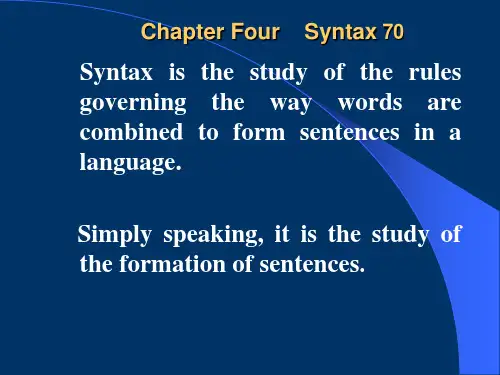
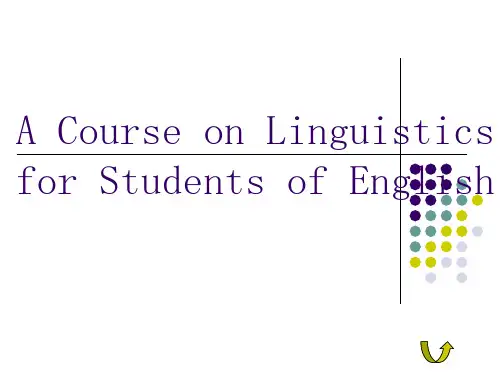
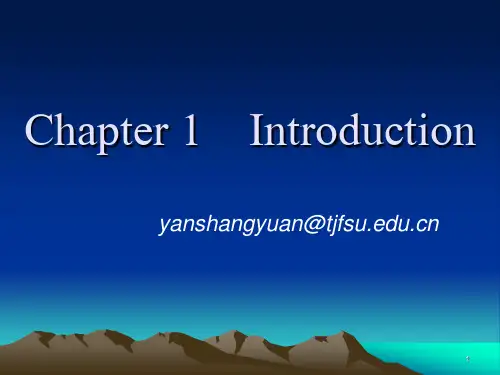

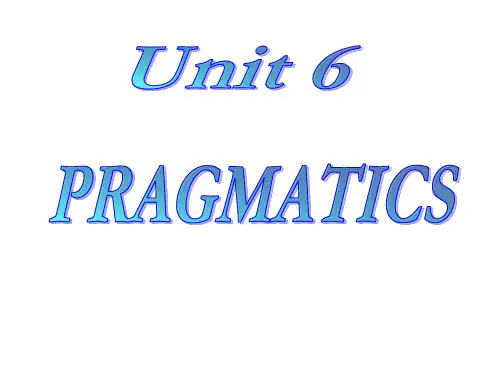
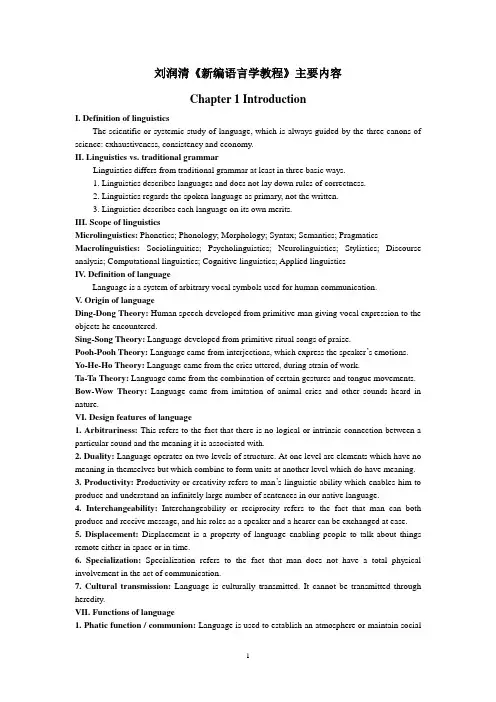
刘润清《新编语言学教程》主要内容Chapter 1 IntroductionI. Definition of linguisticsThe scientific or systemic study of language, which is always guided by the three canons of science: exhaustiveness, consistency and economy.II. Linguistics vs. traditional grammarLinguistics differs from traditional grammar at least in three basic ways.1. Linguistics describes languages and does not lay down rules of correctness.2. Linguistics regards the spoken language as primary, not the written.3. Linguistics describes each language on its own merits.III. Scope of linguisticsMicrolinguistics: Phonetics; Phonology; Morphology; Syntax; Semantics; Pragmatics Macrolinguistics:Sociolinguitics; Psycholinguistics; Neurolinguistics; Stylistics; Discourse analysis; Computational linguistics; Cognitive linguistics; Applied linguisticsIV. Definition of languageLanguage is a system of arbitrary vocal symbols used for human communication.V. Origin of languageDing-Dong Theory: Human speech developed from primitive man giving vocal expression to the objects he encountered.Sing-Song Theory: Language developed from primitive ritual songs of praise.Pooh-Pooh Theory: Language came from interjections, which express the speaker’s emotions. Yo-He-Ho Theory: Language came from the cries uttered, during strain of work.Ta-Ta Theory: Language came from the combination of certain gestures and tongue movements. Bow-Wow Theory:Language came from imitation of animal cries and other sounds heard in nature.VI. Design features of language1. Arbitrariness: This refers to the fact that there is no logical or intrinsic connection between a particular sound and the meaning it is associated with.2. Duality: Language operates on two levels of structure. At one level are elements which have no meaning in themselves but which combine to form units at another level which do have meaning.3. Productivity: Productivity or creativity refers to man’s linguistic ability which enables him to produce and understand an infinitely large number of sentences in our native language.4. Interchangeability:Interchangeability or reciprocity refers to the fact that man can both produce and receive message, and his roles as a speaker and a hearer can be exchanged at ease.5. Displacement: Displacement is a property of language enabling people to talk about things remote either in space or in time.6. Specialization: Specialization refers to the fact that man does not have a total physical involvement in the act of communication.7. Cultural transmission:Language is culturally transmitted. It cannot be transmitted through heredity.VII. Functions of language1. Phatic function / communion: Language is used to establish an atmosphere or maintain socialcontact between the speaker and the hearer. Greetings, farewells and comments on the weather serve this function.2. Directive function:Language is used to get the hearer to do something. Most imperative sentences are of this function.3. Informative function: Language is used to tell something, to give information, or to reason things out. Declarative sentences serve this function.4. Interrogative: Language is used to ask for information from others. All questions expecting replies serve this function.5. Expressive function:Language is used to reveal the speaker’s attitudes and feelings. Ejaculations serve this function.6. Evocative function:Language is used to create certain feelings in the hearers. Jokes, advertising, and propaganda serve this function.7. Performative function:Language is used to do things or to perform acts. The judge’s imprisonment sentences, the president’s declaration of war or the Queen’s naming of a ship, etc., serve this function.VIII. Some major concepts in linguistics1. Descriptive and prescriptive grammar(1) Descriptive grammars attempt to tell what is in the language; while prescriptive grammars tell people what should be in the language.(2) As traditional grammars tried to lay down rules, they are often called prescriptive. Most modern linguistics is descriptive.2. Synchronic and diachronic linguisticsWhen we study language at one particular time, it is called synchronic linguistics. When we study language developments through time, it is called diachronic or historical linguistics. Synchronic linguistics focuses on the state of language at any point in history while diachronic linguistics focuses on the differences in two or more than two states of language over decades or centuries.3. Lange and paroleF. de Saussure made an important distinction between langue and parole: Langue refers to the abstract linguistic system shared by all the members of a speech community. Parole refer to particular realization s of langue. Langue is the social, conventional side of language, while parole is individualized speech.4. Competence and performanceAccording to Chomsky, competence refers to the knowledge that native speakers have their language as a system of abstract formal relations, while performance refers to their actual linguistic behavior, that is, the actual use of this knowledge.5. Syntagmatic and paradigmatic relationsSaussure has put forward another pair of concepts: syntagmatic and paradigmatic relations. The former refers to the horizontal relationship between linguistic elements, which form linear sequences. The later means the vertical relationship between forms, which might occupy the same particular place in a structure.6. Functionalism and formalismFunctionalism or functional linguistics refers to the study of the forms of language in reference to their social function in communication.Formalism or formal linguistics is the study of the abstract forms of language and their internal relations.Chapter 2 Sounds in languageI. Phonetics1. Phonetics:The study of the speech sounds that occur in all human languages is called phonetics.2. Three major research fields of PhoneticsArticulatory phonetics: It is the study of how speech sounds are produced, or articulated. Acoustic phonetics: It deals with the transmission of speech sounds through the air.Auditory phonetics: It deals with how speech sounds are perceived by the listener.II. Articulators1. Seven major articulators:pharynx, velum or soft palate, hard palate, alveolar ridge or alveolum, tongue, teeth and lips2. Voiced and voiceless soundsWhen the vocal cords are spread apart, the airstream from the lung is not obstructed at the space between vocal cords and passes freely. The sounds produced in this way are described as voiceless sounds.When the vocal cords are drawn together, the airstream forces its way through and causes them to vibrate. Sounds produced in this way are described as voiced sounds.3. Nasal and oral soundsWhen the velum is lowered, air escapes through the nose as well as the mouth; sounds produced this way are called nasal sounds.When the velum is raised all the way to touch the back of the throat, the passage through the nose is cut off, the air can escape only through the mouth. Sounds produced this way are called oral sounds.III. Classification of English speech sounds1. Consonants(1) Consonants: consonants are sounds produced by constricting or obstructing the vocal tract at some places to divert, impede or completely shut off the flow of air in the oral cavity.(2) Manner of articulation and place of articulationManner of articulation refers to the type of stricture involved in the production of a consonant (the particular way the airstream is obstructed).Place of articulation refers to the involvement of the articulators in the production of a particular consonant (where the airstream is most obstructed).(3) Classification of consonantsIn terms of manners of articulation, consonants can be grouped into stops, fricatives, affricated, liquids, nasals and glides.In terms of place of articulation, the consonants can be grouped into bilabials, labiodentals, dentals, alveolars, palatals, velars and glottal.2. Vowel(1) Vowels: vowels are sounds produced without obstruction, so no turbulence or a total stopping of the air can be perceived.(2) The height of the tongue: front vowel; central vowels; back vowels(3) The shape of the lips: rounded vowels; unrounded vowels(4) The width of the mouth: open vowels; close vowels; semi-open vowels(5) Monophthongs and diphthongsMonophthongs: They are those pure vowels that have an unchanging quality, either from the number or the con stant quality.Diphthongs: A sequence of two sounds produced from one vowel position to anther.IV. Variations of sounds1. Liaison: The phenomenon of the linking of two words in speech, in particular when the second word begins with a vowel, is called liaison.2. Elision: The loss of a sound or sounds in speech is called elision.3. Assimilation: The way that sounds belonging to one word or one syllable can cause change in sounds belonging to neighboring words or syllables is called assimilation.V. Phonology1. Phonology:phonology is the description of the systems and patterns of speech sounds in a language.2. Phoneme:phoneme is a basic unit of phonological study, and it is an abstract collection of phonetic features which can distinguish meaning.3. Minimal pairs and setsMinimal pairs are pairs of words which differ from each other only by one sound.When a group of words can be differentiated each one from the others, by changing one phoneme (always in the same position), then we have a minimal set.4. Free variation: When two or more sounds occur in the same position without any apparent change of meaning, they are said to be in free variation.5. Distinctive features: When a feature distinguishes one phoneme from another it is a distinctive feature (or a phonemic feature).VI. Syllables and consonant cluster1. Syllables: The English word beautiful consists of three speech units: beau-ti-ful. These units, which are often longer than one sound and smaller than a whole word, are called syllables. Syllable structure:syllableonset rime (rhyme)nucleus (peak) codaconsonant(s) vowel consonant(s)2. Consonant cluster: In English some words may contain a sequence of two or more consonants in one syllable, for example, /spl/ in /′splendid/. Sequences of consonants like this are called consonant clusters.VII. Suprasegementals1. Suprasegmental features: The sound contrasts that extend over several segments (phonemes), are called suprasegmentals.2. Stress: When a word has more than one syllable, one of them will be pronounced with more prominence than others. This brings us to the speech sounds phenomenon, that of stress.3. Intonation: Speech sounds which are identical as to their place or manner features may differ in length, pitch or loudness. When speaking, people generally raise and lower the pitch of their voice. This phenomenon is called intonation.Chapter 3 MorphologyI. Morphology: morphology, as a branch of linguistics, is the study of the internal structure, forms and classes of words.II. MorphemeMorpheme: morpheme is the smallest unit of language, a unit that cannot be divided into further smaller units without destroying or drastically altering the meaning, whether it is lexical or grammatical.2. Types of morphemes(1) Free morphemeFree morphemes are those which may occur alone or constitute words by themselves. All monomorphemes are free morphemes and polymorphemic words, which consist wholly of free morphemes, are compounds.A word must contain an element that can stand by itself, that is, a free morpheme, such as talk. Such an element is called a root. A word may contain more than one root.When they are used with bound morphemes, the basic word-form involved is technically as the stem.Free morphemes can be divided into two categories. The first one is the set of message we convey. These free morphemes are called lexical morphemes and, since we can create new lexical morphemes for the language rather easily, they are called an open class of words.The second category of free morphemes is called functional morphemes. As we almost never add new functional morphemes to the language, they are called a closed class of words.(2) Bound morphemesSome morphemes cannot normally stand alone, but function only as parts of words, e.g. –s, -er, -ed and –ing. Such morphemes are called bound morphemes.Bound morphemes are actually affixes. All affixes in English are bound. Affixes can be joined to the beginning of the root or stem, in which case they are called prefixes. Prefixes can change the meaning or function of the word.Affixes can also be joined to the end of the root or stem, in which case they are called suffixes. Suffixes can also change the meaning or function of the word.Bound morphemes can be classified into two categories. One category is derivational morphemes, which are used to make new words in the language and are often used to make words of a different grammatical category from the stem.The other category is inflectional morphemes, which are not used to produce new words, but rather to show aspects of the grammatical function of a word.III. Morphs and allomorphMorphs are the smallest meaningful phonetic segments of an utterance on the level of parole.An allomorph is a set of morphs which represent the same morpheme. Allomorphs are phonological or orthographic variants of the same morpheme.IV. Types of word formation1. Compounding:By means of compounding, two free morphemes are combined to form acompound. Compounds have strict patterns. The first element in the compound receives the main stress, but it is generally the second element that determines the compound’s new word class.2. Derivation: Derivation is done by adding affixes to other words or morphemes. In contrast to compounding, a derivational word consists of at least a free morpheme and a bound morpheme.3. Other ways of word formation(1) Conversion: Many words have more than one part of speech. A noun can become a verb easily and a verb can be used as a noun. Such instances are called conversion. Conversion is also called zero derivation.(2) Backformation: There are times when we remove a suffix to get a new word. For example, as we have editor, we get edit by dropping or. This process is called backformation.(3) Clipping: The process by which parts of a word have been cut off is called clipping. Clipping occurs when a word of more than one syllable is reduced to a shorter form, often in casual speech.(4) Blending: A single new word can also be formed by combing two separate forms. This process is usually called blending. Typically, blending is finished by taking only the beginning of one word and joining it to the end of another word.(5) Acronym: Some new words are formed from the first letters of a series of words. They are pronounced as a single word.(6) Initialism: Some new words are composed of the first letters of a series of words and pronounced by saying each letter in them. These kinds of words are called initialisms.Chapter 4 SyntaxI. Syntax1. Syntax: Syntax is the study of the rules governing the ways different constituents are combined to form sentences in a language, or the study of the interrelationships between elements in sentence structures.2. Word classesThe general word classes include: nouns; adjectives; verbs; adverbs; prepositions; pronouns and conjunctions.II. Two approaches1. The prescriptive approach: It is an approach taken by some grammarians, mainly in eighteenth century England, which views grammar as a set of rules for the “proper”use of a language, and it is still to be found today and may be best characterized as the prescriptive approach.2. The descriptive approach:Throughout the 20th century, linguists collect samples of the language they are interested in and attempt to describe the regular structures of the language as it is used, not according to some view of how it should be used. This is called the descriptive approach and it is the basis of most modern attempts to characterize the structure of different languages.III. Structural analysisIts main objective is to study the distribution of linguistic forms in a language. The method involves the use of “test-frames” which can be sentences with empty slots in them. By developing a set of test-frames of this type and discovering what forms fit the slots in the test-frames, we can produce a description of some aspects of the sentence structures of a language.1. The constituent structure grammarA grammar which analyzes sentences using only the idea of constituency, which reveals a hierarchy of structural levels, is referred to as a constituent structure grammar.2. Immediate constituent analysis (IC analysis)(1) Definition: The immediate constituent analysis may be defined as the analysis of a sentence in terms of its immediate constituents ——word groups (or phrases), which are in turn analyzed into the immediate constituents of their own, and the process goes on until the ultimate constituents are reached. However, for the sake of convenience, in practice we usually stop at the level of word. The immediate constituent analysis of a sentence may be carried out with brackets or with a tree diagram.(2) Advantages: Through IC analysis, the internal structure of a sentence may be demonstrated clearly, and ambiguities, if any, will be revealed.(3) Problems:①At the beginning, some advocators insisted on binary divisions. Any construction, at any level, will be cut into two parts. But this is not always possible.②Constructions with discontinuous constituents will pose technical problems for tree diagrams in IC analysis. The most serious problem is that there are structural ambiguities which cannot be revealed by IC analysis.IV. The transformational grammar1. Chomsky’s classical theoryIn the earliest version of transformational grammar sometimes now called the “classical theory”—Chomsky put forward a model which consisted of three parts: a set of phrase structure rules, transformation rules and morphophonemic rules.(1) The phrase structure rules were based on constituent structure analysis but formalized as a set of rules. Chomsky emphasized the generative aspect of such rules although any constituent structure grammar is generative by definition, that is, it can produce many sentences.(2) Chomsky then introduced the idea of a set of transformation rules which could transform these simple “kernel” sentences S NP + VP into a number of related sentences.(3) The morphophonemic rules would apply to the output of the transformational rules. Their function was to provide the correct morphological shape to the various parts of the structure and finally to give the appropriate phonological description.2. The standard theory(1) Deep structure and surface structureThe deep structure is the abstract representation of the syntactic properties of a construction, i.e. the underlying level of structural relations between its different constituents.The surface structure is the final stage in the syntactic derivation of a construction, which closely corresponds to the structural organization of a construction people actually produce and receive.(2) The standard theoryDeep structure to SemanticsTransformational componentSurface structure to PhonologyV. Systemic-Functional grammar1. General accountThe characteristics of the theory are systemic and functional. It characterized Halliday’s theory as more attention is paid to paradigmatic relations than to syntagmatic relations. And this is the main concern of Chomsky. What is new in Halliday is that he has tried to relate the functions of language to its structures. He argues that there are three general functions of language: ideational, interpersonal and textual. And they are related to three grammatical systems: transitivity, mood and theme.2. Three general functions of language(1) The function that in which we conceptualize the world for our own benefit and that of others is called ideational function.(2) Language serves to set up and maintain social and personal relations, including communication roles such as questioner and respondent, and to express the language user’s own attitudes and comments on the content of an utterance. This function of language is called interpersonal function.(3) Language also makes links with itself and with features of the situation in which it is used. This is what enables the speaker or writer to construct a text, and enables the listener or reader to distinguish a text from a random set of sentences. This function of language is called textual function.Chapter 5 SemanticsI. Semantics: Semantics is a branch of linguistics which is concerned with the study of meaning in all its formal aspects.II. Some approaches to the study of meaning1. Meaning as naming(1) Referential theory or naming theoryThe meaning of an expression is what it refers to, or names, is often called referential theory or naming theory.(2) ProblemsOne of them is that it is not always immediately obvious what is being named.2. Meaning as conceptAny particular sound image is psychologically associated with a particular concept. Semantic triangleconcept………………………..symbol referent“Symbol” is the linguistic element, i.e. word, sentence, etc. and the “referent” is the object in the world of experience, while “concept” is human thought.3. Meaning as behaviorBloomfield argued that meaning exists in the relation between speech and the practical events that precede and follow it. The meaning of a linguistic form is thus defined as observable behaviors. Such an approach to meaning is called behaviorism, or behaviorist theory, which clearly draws on psychology.4. Meaning as contextThe view that meaning is found in the context within which a particular expression is uttered suggests that we can derive meaning from, or reduce it to, the observable context. Such an approach to meaning clearly draws on sociology.5. Meaning as truth conditionsKnowing the meaning of a sentence is the same as knowing the conditions under which the sentence is true or false. And knowing the meaning of a word or expression is knowing the part that it plays in the truth or falsehood of the sentence containing it. Such an approach to meaning is called truth-conditional theory / semantics, which clearly draws on formal logic.III. Word meaning1. Sense and reference(1) Sense is to be defined in terms of relationships which hold between the linguistic elements themselves (mostly words), it is concerned with intralinguistic relations.(2) Reference or extension deals with the relationship between linguistic elements (words, sentences, etc.) and the non-linguistic world of experience, e.g. things, actions, events and qualities.2. Seven types of meaningAccording to the British linguist G. Leech, meaning in its broadest sense can be classified into seven types: conceptual, connotative, social, affective, reflective, collocative and thematic meanings. Among them, connotative, social, affective, reflective and collocative meanings are called associative meaning.(1) Conceptual meaning also called denotative or cognitive meaning, is the essential and inextricable part of what language is, and is widely regarded as the central factor in verbal communication. Conceptual meaning can be studied in terms of contrastive features or a binary feature formal.(2) Connotative meaning is the communicative value that a word or a combination of words ahs by virtue of what it refers to, over and above its purely conceptual content.(3) Social meaning is the meaning which an expression conveys about the contexts or social circumstances of its use.(4) Affective meaning conveys the language user’s feelings, including his attitude or evaluation in shaping his use of language.(5) Reflective meaning is the meaning which arises in cases of multiple conceptual meanings, when one sense of a word forms part of our response to anther sense.(6) Collocative meaning: The associations a word gets because of the meanings of words which tend to occur in its linguistic context are called collocative meanings.(7) Thematic meaning: It refers to the meaning arises out of the way in which the writer or speaker organizes his message.3. Semantic fields(1) Definition: It is the organization of related words and expression into a system which shows their relationship to one another.(2) Lexical gap: The absence of a word in a particular place in a semantic field of a language is called lexical gap.4. Componential analysisAll lexical items can be analyzed into a set of semantic features or semantic components which may be universal. This semantic theory is called Componential Analysis (CA).5. Major sense relations(1) Homonymy: In any language there are words which have the same linguistic form but are different in meaning.(2) Polysemy: When a word has two or more meanings that are related conceptually or historically, it is said to be polysemous or polysemic. Words of this kind are called polysemic or polysemous words.(3) Homophony:Words which sound alike but are written differently and often have different meanings are called homophones. Homophones are a type of homonymy, so they are sometimes called homonyms.(4) Synonymy: There are not only words that sound the same but have different meanings; there are also words that sound different but have the same meaning. Such words are called synonyms, and the sense relation of “sameness of meaning” is called synonymy.(5) Antonymy:Words that are opposite in meaning are often called antonyms. The oppositeness of meaning is called antonymy.(6) Hyponymy: It is the sense relation between terms in a hierarchy, where a more particular term (the hyponym) is included in the more general one (the superordinate): X is a Y.(7) Metonymy: It is the sense relation between terms which is the part of the other word and also called part / whole relationship. Metonymy can be expressed by the pattern “X is a part of Y.”IV. Sentence meaning1. Sentence and propositionThe semantic content shared by different expressions is a proposition. Generally speaking, one can find out whether the proposition is true or false.As for the relationship between sentences and proposition, different sentences convey the same message——they express the same proposition.2. Semantic roles(1) Definition: It is the way in which the referent of a noun phrase is involved in the situation described or represented by the clause.(2) Classification:Agent & patientExperiencerInstrumentCauseRecipientBenefactiveLocativeTemporal3. Semantic relationships between sentences(1) Entailment: Entailment is a type of meaning-dependence between one sentence and another. In terms of truth value, the following relationships exist between the two sentences if a entails b: When a is true, b is necessarily true; when b is false, a is false; when b is true, a may be true or false.(2) presuppositionIn terms of truth value, the following relationships exist between two sentences: When a is true, b is necessarily true; when a is false, b is till true; when b is true, a can either be true or false; when b is false, no truth value can be said about a.(3) SynonymyTwo sentences may have the same meaning, that is, in terms of truth value, a has the same truth vale as b: If a is true, b is true; also if a is false, b is false; and vice versa.(4) Inconsistency or contradictionA is inconsistent with b: if a is true, b is false; also, if b is true, a is false.(5) ImplicatureImplicature is also a type of semantic relation between two sentences. If we can draw conclusion b from sentence a, here b is the implicature of a.Chapter 6 PragmaticsI. Pragmatics1. Definition: Pragmatics is the study of speakers’intended meaning, or even the “invisible”meaning, that is, how hearers recognize what is meant even when it isn’t actually said or written.2. Difference between pragmatics analysis and grammatical analysisFirst, grammatical studies look for rules while pragmatic studies look for principles.Second, in grammar studies, we end up with products while in pragmatics we always deal with progress.3. Definition of micropragmatics and macropragmatics(1)To study the meaning of the pieces of language in smaller contexts is called micropragmatics. Phenomena such as reference, deixis, anaphora and presupposition, are the topics in this field.(2) To study on the larger chunks of language, and look deep into the mechanisms. This approach of study is called macropragmatics.II. Micropragmatics1. ReferenceAn inference is any additional information used by the hearer to connect what is said to what must be meant.In pragmatics, the act by which a speaker or writer uses language to enable a hearer or reader to identify something is called reference.。
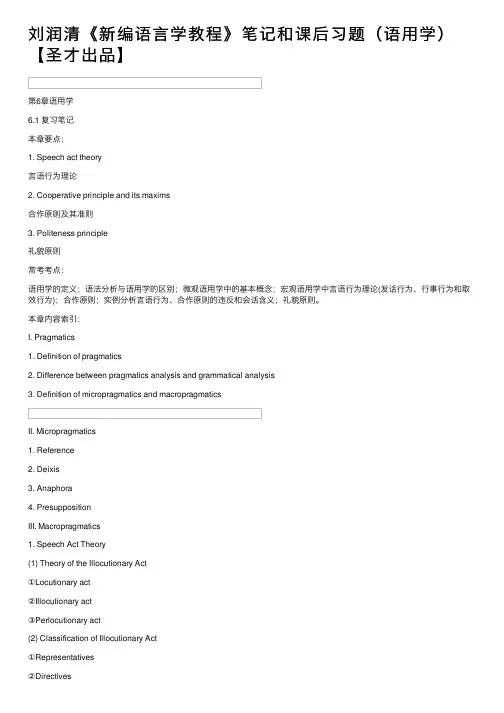
刘润清《新编语⾔学教程》笔记和课后习题(语⽤学)【圣才出品】第6章语⽤学6.1 复习笔记本章要点:1. Speech act theory⾔语⾏为理论2. Cooperative principle and its maxims合作原则及其准则3. Politeness principle礼貌原则常考考点:语⽤学的定义;语法分析与语⽤学的区别;微观语⽤学中的基本概念;宏观语⽤学中⾔语⾏为理论(发话⾏为、⾏事⾏为和取效⾏为);合作原则;实例分析⾔语⾏为、合作原则的违反和会话含义;礼貌原则。
本章内容索引:I. Pragmatics1. Definition of pragmatics2. Difference between pragmatics analysis and grammatical analysis3. Definition of micropragmatics and macropragmaticsII. Micropragmatics1. Reference2. Deixis3. Anaphora4. PresuppositionIII. Macropragmatics1. Speech Act Theory(1) Theory of the Illocutionary Act①Locutionary act②Illocutionary act③Perlocutionary act(2) Classification of Illocutionary Act①Representatives②Directives③Commissives④Expressives⑤Declarations(3) Indirect speech acts2. The Cooperative Principle (CP)(1) Cooperative Principle and Its Maxims(2) Violation of the Maxims3. Politeness Principle (PP)I. Pragmatics(语⽤学)【考点:名词解释】1. Definition of pragmatics(定义)Pragmatics is the study of speakers’intended meaning, or even the “invisible”meaning, that is, how hearers recognize what is meant even when it isn’t actually said or written.语⽤学是研究语⾔实际运⽤的学科,集中研究说话⼈意义、话语意义或语境意义。
目录第1章导言 (6)1.1复习笔记 (6)1.2课后习题详解 (10)1.3考研真题与典型题详解 (13)第2章语音 (23)2.1复习笔记 (23)2.2课后习题详解 (28)2.3考研真题与典型题详解 (30)第3章形态学 (39)3.1复习笔记 (39)3.2课后习题详解 (41)3.3考研真题与典型题详解 (44)第4章句法 (52)4.1复习笔记 (52)4.2课后习题详解 (55)4.3考研真题与典型题详解 (58)第5章语义学 (67)5.1复习笔记 (67)5.2课后习题详解 (72)5.3考研真题与典型题详解 (76)第6章语用学 (87)6.1复习笔记 (87)6.2课后习题详解 (91)6.3考研真题与典型题详解 (93)第7章语篇分析 (101)7.1复习笔记 (101)7.2课后习题详解 (104)7.3考研真题与典型题详解 (106)第8章社会语言学 (110)8.1复习笔记 (110)8.2课后习题详解 (112)8.3考研真题与典型题详解 (115)第9章心理语言学 (123)9.1复习笔记 (123)9.2课后习题详解 (125)9.3考研真题与典型题详解 (127)第10章认知语言学 (131)10.1复习笔记 (131)10.2课后习题详解 (134)10.3考研真题与典型题详解 (136)第11章语言习得 (138)11.1复习笔记 (138)11.2课后习题详解 (142)11.3考研真题及真题详解 (144)12.1复习笔记 (153)12.2课后习题详解 (156)12.3考研真题与典型题详解 (158)第1章导言1.1复习笔记本章要点:1. The definition and main branches of linguistics study语言学的定义和研究的范围2. The definition and the origins of language语言的定义与起源3. The design feature and the function of language语言的特征和功能4. Some major concepts in linguistics语言学中重要的概念本章考点:1. 有关语言学的常考考点(1) 语言学的定义,现代语言学与传统语法学研究的区别。